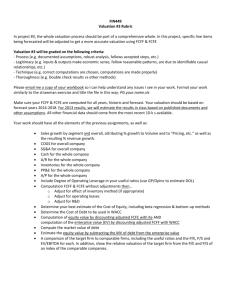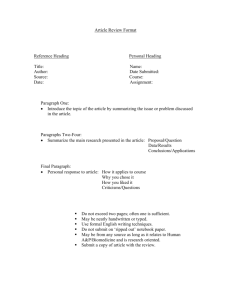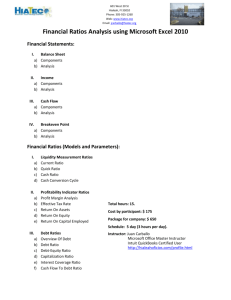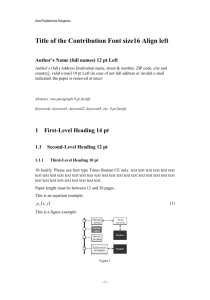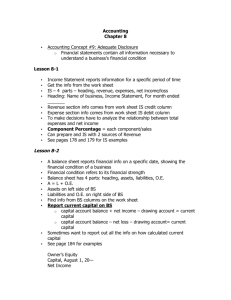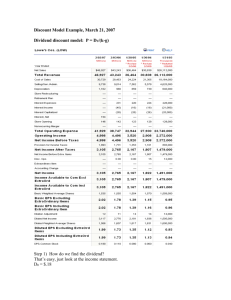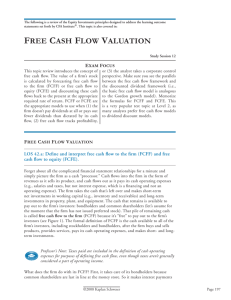General Outline
advertisement
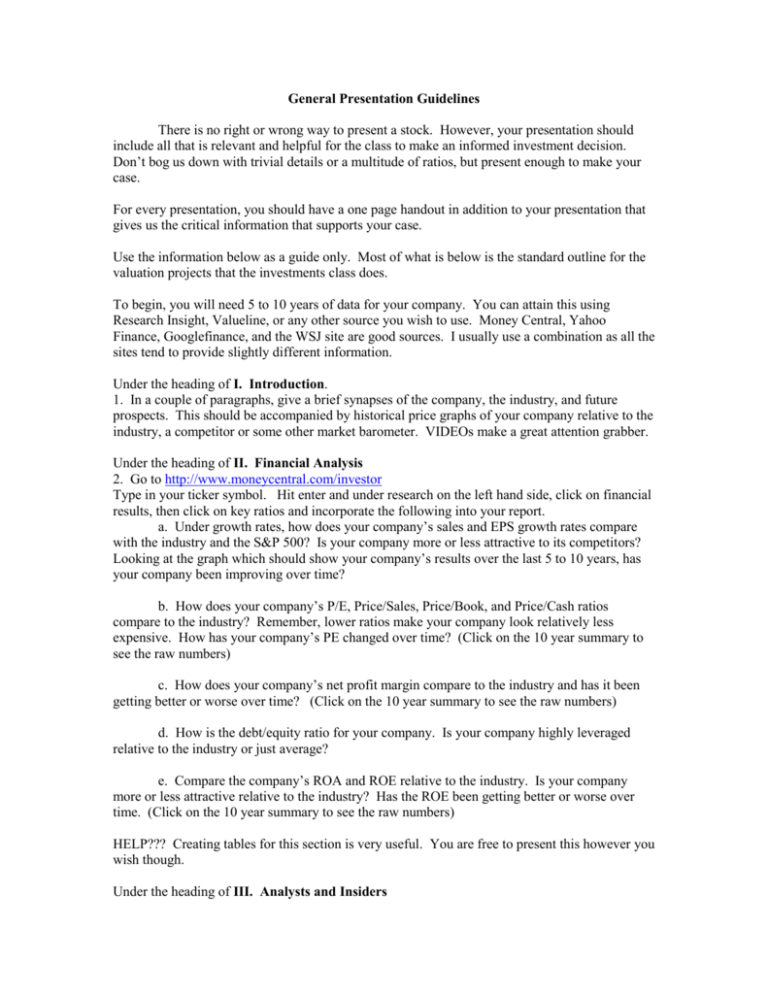
General Presentation Guidelines There is no right or wrong way to present a stock. However, your presentation should include all that is relevant and helpful for the class to make an informed investment decision. Don’t bog us down with trivial details or a multitude of ratios, but present enough to make your case. For every presentation, you should have a one page handout in addition to your presentation that gives us the critical information that supports your case. Use the information below as a guide only. Most of what is below is the standard outline for the valuation projects that the investments class does. To begin, you will need 5 to 10 years of data for your company. You can attain this using Research Insight, Valueline, or any other source you wish to use. Money Central, Yahoo Finance, Googlefinance, and the WSJ site are good sources. I usually use a combination as all the sites tend to provide slightly different information. Under the heading of I. Introduction. 1. In a couple of paragraphs, give a brief synapses of the company, the industry, and future prospects. This should be accompanied by historical price graphs of your company relative to the industry, a competitor or some other market barometer. VIDEOs make a great attention grabber. Under the heading of II. Financial Analysis 2. Go to http://www.moneycentral.com/investor Type in your ticker symbol. Hit enter and under research on the left hand side, click on financial results, then click on key ratios and incorporate the following into your report. a. Under growth rates, how does your company’s sales and EPS growth rates compare with the industry and the S&P 500? Is your company more or less attractive to its competitors? Looking at the graph which should show your company’s results over the last 5 to 10 years, has your company been improving over time? b. How does your company’s P/E, Price/Sales, Price/Book, and Price/Cash ratios compare to the industry? Remember, lower ratios make your company look relatively less expensive. How has your company’s PE changed over time? (Click on the 10 year summary to see the raw numbers) c. How does your company’s net profit margin compare to the industry and has it been getting better or worse over time? (Click on the 10 year summary to see the raw numbers) d. How is the debt/equity ratio for your company. Is your company highly leveraged relative to the industry or just average? e. Compare the company’s ROA and ROE relative to the industry. Is your company more or less attractive relative to the industry? Has the ROE been getting better or worse over time. (Click on the 10 year summary to see the raw numbers) HELP??? Creating tables for this section is very useful. You are free to present this however you wish though. Under the heading of III. Analysts and Insiders 3. a. Now click on analyst ratings on the left hand side of the screen. What are they saying? b. Now click on insider trading. What are they doing? How does this information help us in deciding whether now is a good time to buy or sell? c. Now let’s see what everyone else is saying as well. There are lots of discussion boards to read. Googlefinance has a nice one as does MotleyFool. Let us look at MotleyFools. http://caps.fool.com/Ticker/IBM.aspx Replace IBM with your ticker. Read the top Bull and Bear pitch. The community results which are usually always bullish are moderately useful, but the greater advantage is to look through the discussions. You will often find information that you were not aware of that could help you with making a decision. Under the heading of IV. Relative Valuation 4. a. Create a PE table like you did in your Walmart assignment. Also create a Price/Sales table. The only difference for the price sales table is that you now estimate a pessimistic, expected, and optimistic price/sales ratio along with revenue estimates. To attain revenue estimates, go to http://finance.yahoo.com/ as moneycentral only provides earnings estimates. After typing in your ticker, on the left hand side, click Analyst Estimates. There should be an average, low, and high estimate. Use the next year figures as we are trying to calculate what your stock will be worth next year. b. After calculating your stock estimates, you can also calculate return estimates by simply taking next year’s expected price and dividing it by the current stock price minus one to determine your expected return. Do this. Below is an example for the PE: You can use my spreadsheet at http://faculty.etsu.edu/trainor/FNCE%203300/Relative Valuation.xls if you wish. If the current stock price is $25, your PE table would look like this: Table X: Table X shows the stock price estimates for XXX(your stock) in 2009 using PE ratios. Both pessimistic and optimistic PE ratios are given along with the expected PE ratio. These ratios are combined with low, average, and high EPS estimates. The expected stock price and return is $28 and 12% respectively. Estimates range from $18, (-28%) to $48, (92%). PE / Earnings Current: Price = $25, PE = 14.5, EPS = $1.72 Pessimistic = 12 Expected = 14 Optimistic = 16 Low est. = $1.50 $18, -28% $21, -16% $24, -4% Average = $2 $24, -4% $28, 12% $32, 28% High est. = $3 $36, 36% $42, 68% $48, 92% Professor’s advice: Label your tables and always write a short heading so your reader knows what the table is saying. One should be able to just look at the table heading and know what it is being said without having to read the body of your report. Under the heading IV. Fundamental Valuation 5. Now perform a fundamental valuation for your company using the FCFE model. Use the three period model. You should follow the steps a-d below for this evaluation. Explain what you are doing in your paper. Steps for Fundamental Valuation a. Find your stock’s beta and the current 10 year treasury bond rate. The required return for your evaluation is calculated by using the CAPM which is Ri = rf + Beta[E(Rm) – rf]. For [E(Rm) – rf], let’s use the historical average of approximately 5.5%. If you are not happy with this required return, adjust it as you see fit but explain why you are adjusting it. For most stocks, your answer should be between 8% and 15%. For some stocks, this may even be higher. b. Calculate the growth rate for your company by using ROE * (1 – payout ratio) where the payout ratio is calculated by dividing dividends by earnings or net income. In addition, find the five year analyst’s forecast. This can be found at quicken.com or other sites. To estimate the growth rate of your company, average the two numbers you have found. c. Calculate the FCFE for your company. The formula is Net Income + depreciation – Cap. Expend. – change in working capital – principal debt repayments + new debt issues. Note, we definitely want to look out for capital expenditures since they can be very volatile. Thus, for that figure, let’s just use the average purchases over the last five years(see cash flow statement). Let’s do the same for debt issues and repayments, see cash flow statement. In a steady state, depreciation and capital expenditures should just offset each other as the firm just replaces worn out equipment each year as with debt issues and repayments. Recall that change in working capital is just the change in (Current Assets – current liabilities.) Still having problems????? Depending on the company, you might just want to use operating cash flow. You can also adjust current assets by ignoring cash balances and for current liabilities, ignore notes payable. If you want to assume that the company will finance future growth by the same debt/equity ratio, you can use this formula to find FCFE: FCFE = NI – (1 – DR)(Capital Spending + change in Working Capital – Depreciation). Having problem with working capital, find working capital as a % of sales, then the change will be current working capital/sales * growth rate * current working capital. Example: WC = 100, sales = 5000. WC/Sales = 2%. Sales is expected to increase by 8%. Thus, change in WC would be .02 * .08 * 100 = 4. This is only a good idea if WC is positive. You should also find the average of WC/Sales based on at least 3 years of data. d. Using a three stage growth model, calculate the intrinsic value of your stock assuming current growth continues for five more years. After your initial growth period, assume it slows to 5% in stage 3 over the next 5-10 years depending on the company. Use the following three stage model on my website. This site also has the inputs to find FCFE base on FCFE = NI – (1 – DR)(Capital Spending + change in Working Capital – Depreciation) and change in working capital. http://faculty.etsu.edu/trainor/FNCE 3300/fcfe3st.xls Under the heading V. Recommendation 6. In a half page summary, what is your recommendation for this stock? Buy, sell, or hold. Give me an expected value and a range. Relate this to the current price. What is your recommendation?
